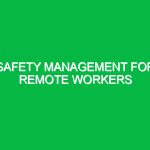In today’s industrial landscape, safety is not just a regulatory requirement; it is a moral obligation. Industrial Safety Protocols serve as the backbone of operational integrity, ensuring that organizations protect their most valuable assets: their employees and the environment. These protocols encompass a comprehensive set of guidelines aimed at mitigating risks associated with industrial operations. They are not merely a checklist of do’s and don’ts; they represent a culture of safety that permeates every level of an organization. By prioritizing health, safety, and environmental (HSE) standards, companies can foster a safer workplace while enhancing productivity and efficiency.
The Importance of Industrial Safety Protocols
Industrial Safety Protocols are crucial for several reasons. First and foremost, they help prevent accidents and injuries. According to the U.S. Bureau of Labor Statistics, thousands of workplace injuries occur every year, often due to inadequate safety measures. Beyond the human cost, accidents can lead to significant financial losses, including regulatory fines, increased insurance premiums, and operational downtime. Implementing robust safety protocols not only protects employees but also safeguards the company’s financial future.
Moreover, adhering to these protocols enhances a company’s reputation. In an era where corporate responsibility is increasingly scrutinized, organizations that prioritize safety demonstrate their commitment to ethical practices. This can lead to improved employee morale, lower turnover rates, and a more positive public image. Ultimately, strong Industrial Safety Protocols are a win-win for both employees and employers.
Identifying Hazards and Risks in Industrial Settings
To effectively implement Industrial Safety Protocols, it is essential to identify the potential hazards and risks present in industrial environments. These hazards can be categorized into several types:
Physical Hazards
Physical hazards include any environmental factors that can cause harm. This can range from machinery, tools, and electrical components to slip, trip, and fall risks. For instance, an employee working in a manufacturing plant may be exposed to rotating machinery without proper guards, significantly increasing the risk of injury.
Chemical Hazards
Chemical hazards involve exposure to harmful substances, including toxic chemicals, flammable materials, and corrosives. For example, a worker in a chemical plant may handle solvents without adequate protection, risking skin burns or respiratory issues. It is essential to conduct thorough assessments of all chemicals used in industrial processes to ensure proper handling and storage procedures are established.
Biological Hazards
Biological hazards are less common in traditional industrial settings but still pose significant risks, especially in industries like agriculture and waste management. Employees may face exposure to bacteria, viruses, or other pathogens. For instance, workers in a waste treatment facility might encounter harmful microorganisms if proper hygiene protocols are not followed.
Ergonomic Hazards
Ergonomic hazards arise from poor workplace design that can lead to musculoskeletal disorders. Jobs that require repetitive motion, awkward postures, or heavy lifting can increase the risk of injuries. A notable example is assembly line workers who perform the same task repeatedly without proper ergonomic assessments.
Best Practices for Implementing Safety Protocols
Once hazards are identified, organizations should develop and implement best practices tailored to their specific risks. Here are some actionable strategies:
Conduct Regular Risk Assessments
Regular risk assessments are vital. These assessments should evaluate all aspects of the workplace, including equipment, processes, and employee behaviors. By identifying potential hazards proactively, companies can implement necessary changes before incidents occur.
Provide Comprehensive Training
Training is a cornerstone of effective Industrial Safety Protocols. Employees should receive training not only on general safety practices, but also on specific procedures relevant to their roles. For example, a technician working with heavy machinery should understand lockout/tagout procedures to prevent accidental machine startups during maintenance. Training should be ongoing, incorporating refreshers and updates as new hazards or changes in equipment arise.
Establish Clear Communication Channels
Effective communication is essential for promoting a culture of safety. Employers should encourage employees to report unsafe conditions without fear of reprisal. Implementing a system for reporting hazards can facilitate timely interventions to mitigate risks. Regular safety meetings can also keep safety at the forefront of employees’ minds.
Utilize Personal Protective Equipment (PPE)
Personal Protective Equipment (PPE) is a fundamental component of industrial safety. Employers must provide appropriate PPE, such as helmets, gloves, goggles, and respiratory protection, based on the risks identified in the workplace. Moreover, training employees on how to properly use and maintain their PPE is equally important. A personal experience from a manufacturing plant illustrates this: an employee who neglected to wear safety goggles while operating a cutting machine suffered a severe eye injury. This incident not only affected the individual but also resulted in operational delays and increased insurance costs.
Implement Emergency Response Plans
An effective emergency response plan can make a significant difference in mitigating the impact of accidents. Organizations should develop and regularly practice emergency procedures for various scenarios, such as chemical spills, fires, or equipment malfunctions. Having a well-rehearsed plan ensures that employees know their roles in an emergency, which can save lives and minimize property damage.
Regulations and Standards Governing Industrial Safety Protocols
Compliance with various regulations and standards is integral to effective Industrial Safety Protocols. In the United States, the Occupational Safety and Health Administration (OSHA) sets forth regulations that outline employer responsibilities to ensure workplace safety. These regulations encompass a wide range of industries and include standards for specific hazards, such as the Hazard Communication Standard, which requires employers to inform employees about chemical hazards.
Internationally, the ISO 45001 standard provides a framework for occupational health and safety management systems. This standard emphasizes the importance of proactive measures and continuous improvement in safety practices. Adopting these regulations not only helps organizations comply with legal requirements but also fosters a culture of safety that can lead to improved overall performance.
Conclusion
In summary, Industrial Safety Protocols are essential for protecting employees and the environment in industrial settings. By understanding potential hazards and implementing best practices, organizations can create a safer workplace. Regular training, clear communication, and adherence to regulations play a pivotal role in establishing a culture of safety. As industries continue to evolve, so too must our commitment to safety. Investing in Industrial Safety Protocols is not merely a legal obligation; it’s a commitment to the well-being of every individual who contributes to the success of the organization.
Ultimately, the journey toward safety is ongoing. Each incident provides an opportunity for learning and improvement. By embracing this mindset, organizations can not only meet compliance standards but also cultivate a workplace where safety is valued above all else.


